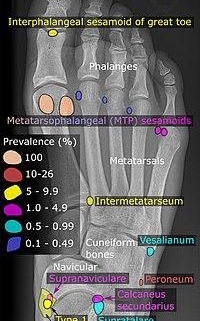
Sesamoid
Overview of Sesamoid
Sesamoids are a unique type of bone found in the human body. These small, pea-sized bones are located in the underside of your foot, specifically under the big toe. Some people also have them in their hands. Sesamoids are special because they are embedded within tendons or muscle, unlike most bones that link together via joints. A common issue that people face related to sesamoids is sesamoiditis, which is an inflammation or injury of the sesamoid bones. This condition can be painful and potentially debilitating if not treated properly.
Types of Sesamoid Conditions
There are a few conditions associated with the sesamoid bones:
1. Sesamoiditis: An overuse injury that results in chronic inflammation of the sesamoid bones and tendons surrounding them.
2. Sesamoid fractures: This can either be an acute injury (sudden break due to trauma) or chronic (a stress fracture due to repeated stress over time).
3. Turf Toe: Although it’s not related to the sesamoid bones directly, this injury of the main joint of the big toe can affect the sesamoid bones.
Causes of Sesamoid Conditions
Sesamoid conditions are generally caused by overuse of the tendons surrounding the sesamoid bones. Other potential causes include:
– Direct trauma or injury to the foot.
– High levels of stress on the feet due to physical activities like playing sports, running, ballet dancing, etc.
– Wearing shoes that do not provide proper support or fit improperly.
– Having high arches or supinated feet, which can put added stress on the sesamoids.
Symptoms of Sesamoid Conditions
Common symptoms of sesamoid conditions include:
– Pain under the big toe or on the ball of the foot.
– Swelling and bruising.
– Difficulty and pain while bending and straightening the big toe.
– Limping or difficulty walking.
Diagnosis of Sesamoid Conditions
Diagnosis of sesamoid conditions typically involves a physical examination wherein the doctor assesses the foot for pain, swelling, and mobility. In some instances, an X-ray, MRI, or bone scan may be recommended to confirm the diagnosis and rule out fractures.
Treatment Options for Sesamoid Conditions
Treatment of sesamoid conditions varies depending on the severity of the condition. It usually includes:
– Rest and ice to reduce inflammation.
– Anti-inflammatory medications.
– Padding or strapping the ball of the foot.
– Physical therapy.
In more severe cases where conservative treatments fail, surgery may be required to remove the sesamoid bone or repair fractures.
Living with Sesamoid Conditions
Managing sesamoid conditions require certain lifestyle changes:
– Rest your foot regularly and avoid activities that cause pain.
– Wear comfortable, well-fitting shoes that provide adequate support.
– Apply ice packs to the affected area to soothe pain and inflammation.
– Regularly attend physical therapy sessions if recommended by your physician.
When to Seek Help
If you experience persistent pain, unable to walk, or if the swelling does not reduce even after periods of rest and home care, it is crucial to seek medical help immediately. A healthcare professional can adequately diagnose your condition and provide you with suitable treatment options to regain mobility and eliminate pain.
Remember, it’s essential to give your body the care it needs and be proactive about any potential health complications. Be honest with your healthcare provider about your symptoms to ensure you receive the best possible care and treatment for optimal recovery.
